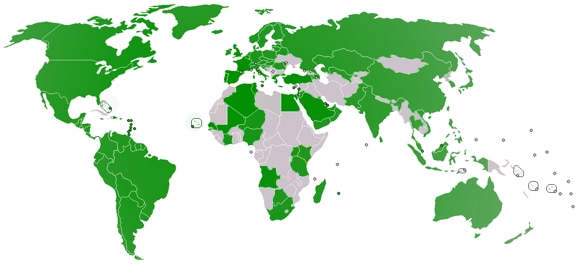 We’re excited for our U.S. readers that Google has introduced its online music service – finally. For the rest of us, we have to wait and see when we’ll be lucky enough to see Google Music’s presence where we live.
We’re excited for our U.S. readers that Google has introduced its online music service – finally. For the rest of us, we have to wait and see when we’ll be lucky enough to see Google Music’s presence where we live.
Google Music went live almost nine years after Apple opened the doors to its iTunes Store. To see what Google is up against, we have collected a plethora of numbers about iTunes from all over the Web.
As you will see, Google is facing some long odds. We hope for Google’s sake this isn’t a case of too little, too late, considering what a behemoth they are competing with.
History of the iTunes Music Store
Note that we’ve tried to focus as much as possible on the iTunes Store and music, and not included any data for apps, video, and other content in Apple’s media hub.

The complete Beatles collection arrived in the iTunes Music Store in November 2010. Picture courtesy of Apple Inc.
- January 9, 2001 – Steve Jobs introduced iTunes (the application) at Macworld Expo.
- April 28, 2003 – Apple’s iTunes Store opened.
- October 2003 – iTunes for Windows arrived.
- April 2003 to September 2008 – iTunes 4 was the most long-lived release of the iTunes application.
- Five weeks in 2005 – iTunes 5 was the most short-lived release.
- 99 cents – The iTunes Store launched with a flat price structure, all songs cost exactly the same.
- 69 cents, 99 cents, and $1.29 – In 2009 the flat pricing structure was replaced with a three-tier pricing structure.
- 80% – On January 6, 2009, Apple announced that DRM (Digital Rights Management, copy protection if you like) had been removed from the majority of the entire music catalog in the U.S. The DRM-free music is called iTunes Plus.
- 100% – Full iTunes Plus availability was achieved on April 7, 2009 in the U.S., coinciding with the introduction of the three-tiered pricing model.
- 10.5.1 – iTunes Match debuted on 14 November 2011 together with a new version of the iTunes application.
iTunes Music Store downloads and sales

- 200,000 – The number of items available to purchase in the iTunes Store when it opened.
- 1 million – Apple sold this many tracks in the first week after the iTunes Store opened.
- 1 million – When released for Windows in October 2003, iTunes was downloaded more than 1 million times in the first three days.
- 25 million – On December 15, 2003 Apple announced that it had crossed 25 million songs sold.
- 800,000 – The European iTunes Music Stores sold a combined total of this many songs in one week after opening in June 2004.
- 450,000 – The United Kingdom’s share of the 800,000 songs.
- 2.5 million – How many songs customers were buying per week in March 2004.
- 50 million – On March 15, 2004, Apple announced that iTunes Music Store customers had purchased and downloaded this many songs from the iTunes Music Store.
- 70 million – On April 28, 2004, the iTunes Music Store marked its first anniversary with 70 million songs sold.
- 50 millionth – “The Path of Thorns” by Sarah McLachlan, was the 50 millionth downloaded song from the iTunes Music Store in 2004.
- 1 million – The number of songs sold in the Japanese iTunes Store in the first week after it opened in 2005.
- 88% – Steve Jobs announced in his “It’s Showtime” keynote in September 2006 that Apple had control over close to 90% of the digital download market in the U.S.
- 70% – iTunes accounted for 70% of global online digital music sales as of January 2009.
- 1 – Apple’s iTunes Store surpassed Best Buy to become the second biggest music seller in the U.S. behind Wal-Mart on February 26, 2008. iTunes became number one just a few days later on April 3, 2008.
- 35% – Just over a third of all music sales in the U.S. were digital downloads, as of January 2009.
- 69% – iTunes commanded the vast majority of the digital downloads music market, as of January 2009.
- 10 billion – In February 2010, Apple announced that this many iTunes songs had been downloaded.
- 16 billion – That number had grown by 60% by October 2011.
- 25,000 – The number of tracks an iTunes Match customer can upload.
- 20 million – Currently the the number of songs available in iTunes.
iTunes Music Stores around the world

Picture from Wikipedia showing the countries where iTunes Store is available. Note that not all the countries have iTunes Music Stores.
Google Music starts as a U.S.-only service, which iTunes Music Store also did. A quick calculation shows us that over nine years Apple has managed to make its online music offering available in 18% of the countries in the world, which means just over 14% of the world’s total population can buy music from iTunes.
If you go to the Change Country screen in the iTunes application you will see 123 flags as of November 18, 2011. All of these stores don’t carry music however. In fact, most of them just carry apps and podcasts.
We clicked through to verify the 35 countries that currently have iTunes Music Stores.1
Here is the list of iTunes Music Stores around the world and when they were added:
- 2003 (April 28) – U.S. gets the first iTunes Music Store.
- 2004 (June 15): – France, Germany, United Kingdom added.
- 2004 (October 26) – Austria, Belgium, Finland, Greece, Italy, Luxembourg, the Netherlands, Portugal, and Spain added.
- 2004 (December 3) – Canada added.
- 2005 (January 6) – Ireland added.
- 2005 (May 10) – Sweden, Norway, Switzerland, and Denmark added.
- 2005 (August 4) – Japan added.
- 2005 (October 25) – Australia added.
- 2006 (December 6) – New Zealand added.
- 2009 (August 4) – Mexico added.
- 2011 (September 29) – Bulgaria, Cyprus, the Czech Republic, Estonia, Hungary, Latvia, Lithuania, Malta, Poland, Romania, Slovakia and Slovenia added.
Miscellaneous iTunes Music Store factoids

Apple’s data center in Maiden, North Carolina, U.S. Picture from Google Earth.
We finish with a few things that didn’t really fit under the other headings.
- 20 – The number of genres in the U.S. iTunes Music Store.
- 150,000 – The number of podcasts available.
- 20,000 – The number of hours of audiobooks (figure from 2003).
- 200 million – The number of registered iTunes customers with credit cards on file as of March 2011.
- Over half a billion – The number of active iTunes installations in the world, according to Steve Jobs in 2007.
- $1 billion – Estimated cost of Apple’s new data center in Maiden, North Carolina, U.S., which will help accommodate iTunes, along with the new iCloud service and MobileMe.
- $189 million – Total estimated gross profit Apple has earned from iTunes since the service was launched.
- 185 MB – The size of the latest iTunes app (10.5.1) for Mac OS X when installed on one of the latest MacBook Pros.
- 19.1 MB – The download size of version 4.1 of iTunes for Windows.
- $29,500 – In January 2004 at the Macworld Conference & Expo in San Francisco, Steve Jobs announced that an unnamed person had purchased this much worth of music.
- 9 cents – How much the artist gets from a song sold on iTunes
- $1.3 billion – The estimated cost for Apple to run iTunes for a year.
We wish Google good luck
We finish with our sincere congratulations to Google for the launch of its Music service and we look forward to monitor its progress. Competition is good and although Apple’s iTunes may have turned into the dominant force in the online music business that doesn’t mean there is not room for others.
Source if not specifically linked to or mentioned above is Wikipedia’s iTunes Store page.
1 Puerto Rico is listed on the Choose Your Country page online but not on the Change Country screen in the iTunes application so we did not included it in the list in the article.



























